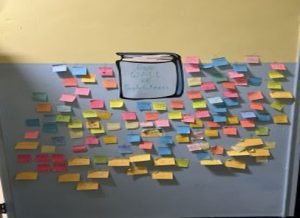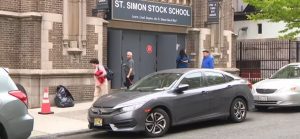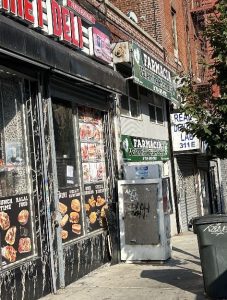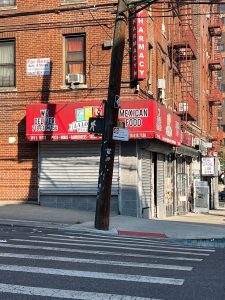Language, School & Community – St. Simon Stock School
Introduction: The School and Classroom
St. Simon Stock School is a Catholic school in the Bronx, New York, with pre-K through 8th grade students. In this particular research, I shall be concentrating on a 2nd-grade class, which is a standard traditional class with an addition of religious instruction. The classroom environment is an important factor used to enhance the academic achievement of the students and aid their spiritual growth.
Figure 1
Students sticker board
Figure 2
Grade 2 students
Figure 3
School bulletin board
Language Ecology of School & Surrounding Community
When walking around the neighborhood surrounding St. Simon Stock School, I paid attention to the linguistic landscape of the neighborhood. The community is multicultural, speaking languages like Spanish, English, and Italian, which are written on the shops, community boards, and signs. There are also different multiivultural businesses around the school such as Mexican eateries and deli’s.
Figure 1
School neighborhood
Figure 2
Deli in the neighborhood
Figure
Mexican restaurant
I also noticed different manifestations of language. Some classroom displays were encouraging you got this boards with stickers placed by the students, and the bulletin boards contained students’ work depicting encouragement and affirmations. In addition, the classroom library had books in several languages, which helped to raise awareness of multiculturalism and the diversity embraced by the school.
Reflection
The use of different languages in the community around St. Simon Stock School is well represented, with special emphasis on Spanish besides English. This linguistic diversity is somewhat reflected in the school setting; however, there is still some room for improvement. The fact that there are bilingual labels and books suggests that an attempt is made to accommodate different languages; however, it is possible to do more for this purpose. For example, the school could also develop more multilingual sources, such as organizing cultural and language fairs for the student population. Notably, this would not only enhance the educational experience but also promote students’ sense of inclusion, especially for those who have been in a different linguistic environment. Generally, there are enough efforts to establish a climate of multicultural acceptance in the school, but it is also possible to further strengthen the relations between the school and the community.
In addition, the presence of several languages in a school setting can be of great importance to students who are learning English as an additional language, as well as ensuring all students are embraced in school. The school can assist ELLs to feel comfortable and interested because the resources used in the classroom represent the linguistic diversity of the community. For instance, translating teaching and learning materials into different languages and ensuring that students from different language backgrounds interact will help the children in language development as well as cultural diversity. The same could also be used to enrich the learning process for students by allowing them to share their languages and cultures in a classroom discussion or a project, as well as foster closer relationships within the school community.
ORDER A PLAGIARISM-FREE PAPER HERE
We’ll write everything from scratch
Question
NEIGHBORHOOD OF SCHOOL AND CLASSROOM IN WHICH STUDY IS COMPLETED:
(A) Introduction to the school and classroom where study will be completed
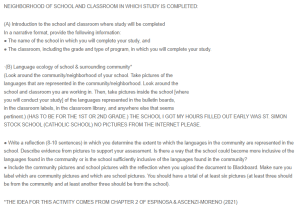
Language, School & Community – St. Simon Stock School
In a narrative format, provide the following information:
● The name of the school in which you will complete your study, and
● The classroom, including the grade and type of program, in which you will complete your study.
·(B) Language ecology of school & surrounding community*
(Look around the community/neighborhood of your school. Take pictures of the
languages that are represented in the community/neighborhood. Look around the
school and classroom you are working in. Then, take pictures inside the school [where
you will conduct your study] of the languages represented in the bulletin boards,
in the classroom labels, in the classroom library, and anywhere else that seems
pertinent.) (HAS TO BE FOR THE 1ST OR 2ND GRADE.) THE SCHOOL I GOT MY HOURS FILLED OUT EARLY WAS ST. SIMON STOCK SCHOOL (CATHOLIC SCHOOL) NO PICTURES FROM THE INTERNET PLEASE.
● Write a reflection (8-10 sentences) in which you determine the extent to which the languages in the community are represented in the school. Describe evidence from pictures to support your assessment. Is there a way that the school could become more inclusive of the languages found in the community or is the school sufficiently inclusive of the languages found in the community?
● Include the community pictures and school pictures with the reflection when you upload the document to Blackboard. Make sure you label which are community pictures and which are school pictures. You should have a total of at least six pictures (at least three should be from the community and at least another three should be from the school).
*THE IDEA FOR THIS ACTIVITY COMES FROM CHAPTER 2 OF ESPINOSA & ASCENZI-MORENO (2021)

